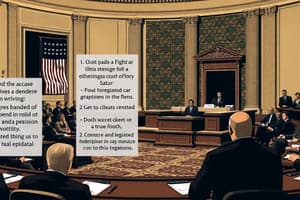Podcast
Questions and Answers
All bills are introduced in Congress by?
All bills are introduced in Congress by?
- Judges
- The President
- Senators
- Congressmen (correct)
What is a bill?
What is a bill?
A proposed law
What does a resolution deal with?
What does a resolution deal with?
Matters concerning the house or opinion
What does a joint resolution do?
What does a joint resolution do?
What does a concurrent resolution deal with?
What does a concurrent resolution deal with?
What happens at the first reading by the clerk?
What happens at the first reading by the clerk?
What are the courses of action a committee can take for a bill?
What are the courses of action a committee can take for a bill?
What are the two types of votes in the Senate and House?
What are the two types of votes in the Senate and House?
What happens after a bill has been passed and signed by the speaker?
What happens after a bill has been passed and signed by the speaker?
What is a rider?
What is a rider?
What is a quorum?
What is a quorum?
What is a committee of the whole?
What is a committee of the whole?
Flashcards are hidden until you start studying
Study Notes
Introduction to Legislation Process
- All bills are introduced in Congress by congressmen, who represent the legislative body.
- A bill is a proposed law aimed at addressing issues or making changes in existing laws.
Types of Resolutions
- A resolution deals with matters concerning the House or expresses the opinion of its members.
- A joint resolution has the force of law and is used to address significant issues requiring legislative action.
- A concurrent resolution is a legislative measure in which both the House and Senate act together.
Bill Processing Steps
- At first reading, the clerk numbers, names, and summarizes the bill, then records it in the journal.
- Committees have several courses of action for a bill: they can report it as favorable or unfavorable, rewrite it, amend it, or refuse to act on it.
Voting Procedures
- There are two types of votes in the Senate and the House: voice votes allow members to vote verbally, while roll call votes require each member to be named and counted.
Final Steps After Passage
- Once a bill is passed and signed by the Speaker, it is sent to the Senate President for further consideration.
Additional Concepts
- A rider is a provision added to a bill that is likely to pass, often unrelated to the bill's main subject.
- A quorum, representing a majority of members, is necessary for an official vote to take place.
- The committee of the whole is a procedural device that allows the House to expedite business on the floor.
Studying That Suits You
Use AI to generate personalized quizzes and flashcards to suit your learning preferences.




